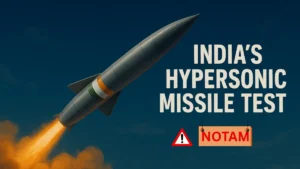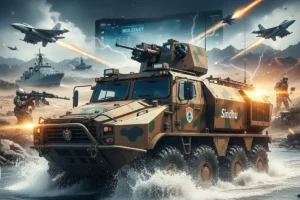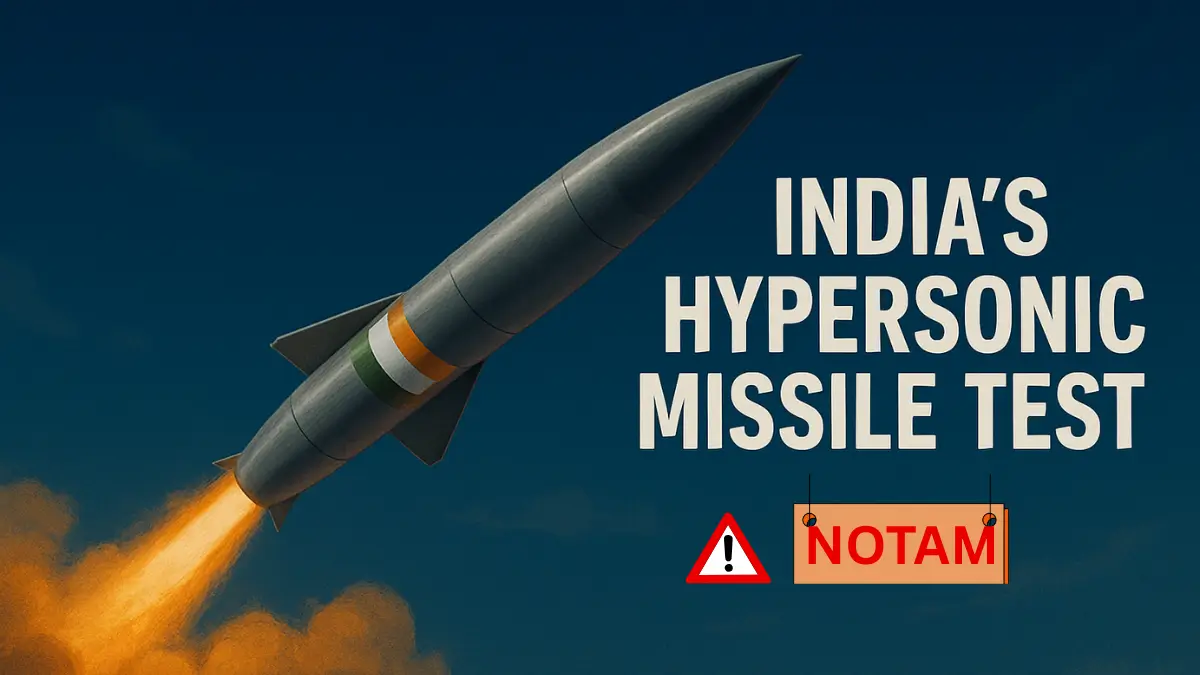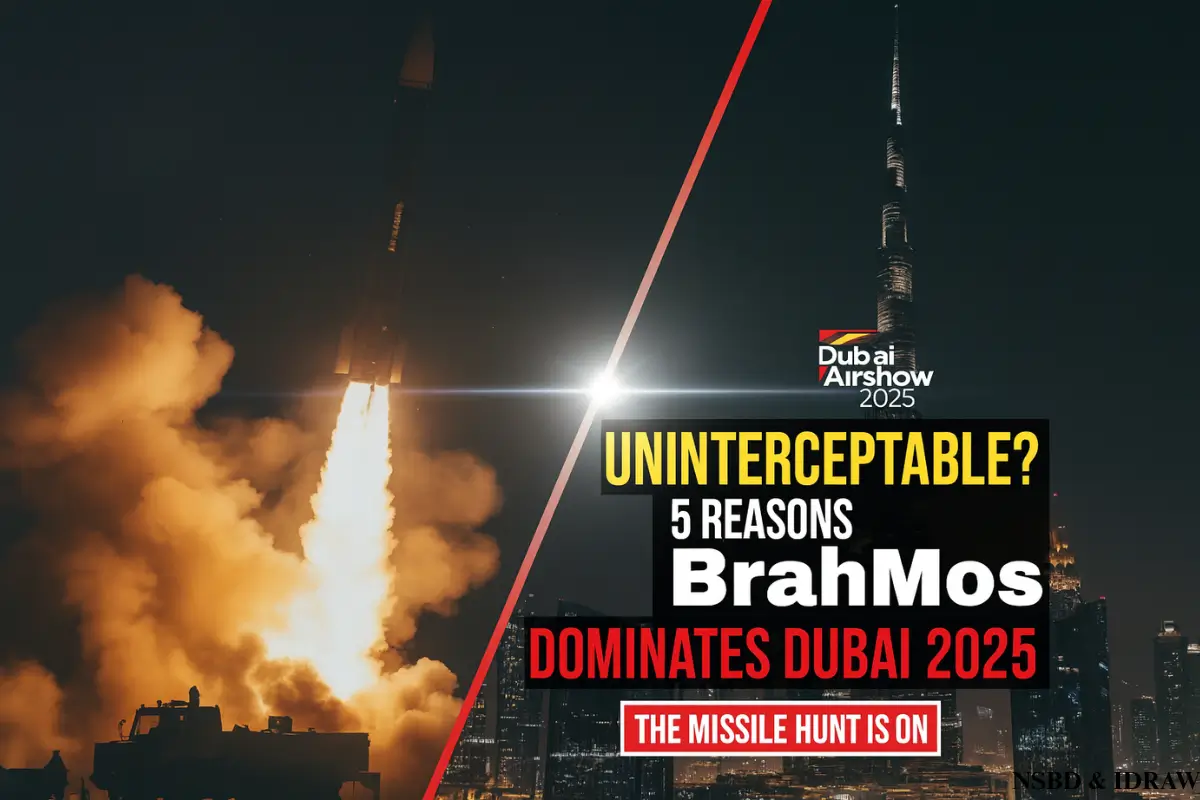In a groundbreaking achievement for India’s strategic defence arsenal, the Defence Research and Development Organisation (DRDO) successfully tested the K-5 submarine-launched ballistic missile (SLBM) Stage-2 motor on November 11, 2025, at the Armament & Combat Engineering (ACEM) facility in Hyderabad. This test represents a pivotal moment in India’s journey toward strengthening its nuclear deterrence capability and completing the critical sea-leg of its nuclear triad.
The test validated the K-5 SLBM Stage-2 motor through a comprehensive static firing that monitored over 250 instrumentation channels in real-time. Every performance parameter—thrust output, propellant burn time, structural integrity, and thermal resistance—matched predictive ballistic models with exceptional precision. For India’s defence establishment, this means one thing: indigenous submarine-based nuclear deterrence is no longer theoretical; it’s becoming an operational reality.
What makes this test extraordinary is not just the technical achievement, but what it symbolises for India’s Aatmanirbhar Bharat vision. India no longer depends on foreign propulsion technology for its undersea nuclear weapons. The K-5 submarine-launched ballistic missile represents homegrown expertise, indigenous innovation, and strategic self-reliance—crucial elements for any mature nuclear power. This breakthrough also signals to the global community that India possesses the technical sophistication to maintain a credible second-strike nuclear deterrent from submarines, ensuring that even if land-based or air-based systems are destroyed, India can still retaliate from invisible underwater platforms.
The K-5 Stage-2 motor test success removes a critical technical bottleneck in the missile development timeline. With this validation, the next phase of underwater launch trials from submarine platforms moves closer to reality, potentially beginning as early as 2025-2026 in the Bay of Bengal.
What Exactly Is the K-5 SLBM?
The K-5 submarine-launched ballistic missile is a three-stage, solid-fuel ballistic missile engineered specifically to operate from India’s nuclear-powered attack submarines (SSBNs). Designed by DRDO’s Advanced Naval Systems Laboratory (ANSL) in Hyderabad, the K-5 SLBM represents the next generational leap in India’s submarine-based nuclear deterrence capability.
Technical Specifications: The K-5 Missile at a Glance
The K-5 SLBM boasts impressive specifications that place it among the world’s advanced submarine-launched systems:
- Operational range: 5,000–6,000 kilometres (enables strikes from secure Indian Ocean bastions to distant targets across Asia and beyond)
- Payload capacity: 2 tonnes (sufficient for a modern thermonuclear warhead or multiple independently targetable warheads)
- Overall length: Approximately 12 meters (compact enough to fit submarine launch tubes)
- Diameter: 2.45 meters (standardised for Arihant-class and future S4-class submarine canisters)
- Launch system: Cold-launch technology (missile ejected by high-pressure gas underwater; engine ignites post-breach)
- Propulsion stages: Three solid-fuel stages providing sequential acceleration, guidance, and final push to target altitude
- Guidance system: Inertial navigation with celestial updates (enabling pinpoint accuracy at extreme ranges)
- Warhead capability: MIRV-ready (multiple independently targetable re-entry vehicles for striking multiple targets)
Platform Compatibility: Which Submarines Carry K-5?
The K-5 missile deployment strategy follows a progressive timeline across India’s nuclear submarine fleet:
INS Arihant & INS Arighaat (Current): Armed with K-15 Sagarika (750 km range) and K-4 Kalam (3,500 km range) respectively. These submarines will not be retrofitted with K-5 due to canister compatibility limitations.
INS Aridhaman (Third SSBN): Expected to be commissioned by 2026–2027; will serve as the primary testbed for K-5 SLBM operational trials. This submarine will carry the K-5 as its primary strategic armament.
Future S4-class submarines: Larger boats (8,000–9,000-tonne displacement) specifically designed with expanded missile bays to accommodate K-5 and eventually K-6 SLBMs. Three S4-class boats planned; first expected induction 2028 onwards.
Future S5-class submarines (2030s): Ultra-large nuclear submarines (13,500-tonne displacement) with 12 missile tubes—each equipped with K-6 SLBM (8,000 km range). This will establish India’s continuous at-sea deterrent (CASD) operation.
Why India Needed K-5: Filling the Strategic Gap
India’s submarine-launched ballistic missile arsenal faced a critical capability gap. The K-15 Sagarika (750 km range) served adequately during the early 2010s, but it lacked the reach to strike distant Chinese targets from secure deep-water launch positions in the Bay of Bengal or Indian Ocean. The K-4 Kalam (3,500 km range) represented a major upgrade, but still fell short of matching the land-based Agni-5 ICBM (5,000+ km range).
The K-5 submarine-launched ballistic missile solves this strategic dilemma. With its 5,000–6,000 km range, K-5 enables Indian submarines to launch from protected waters—areas where naval adversaries cannot easily detect or neutralise them—and strike targets anywhere in the Asian theatre. This fundamentally transforms India’s deterrence calculus, especially vis-à-vis China’s expanding submarine capabilities in the Indian Ocean.
Furthermore, the K-5 SLBM’s MIRV capability (multiple warhead delivery) enhances deterrence value by enabling a single missile to threaten multiple targets simultaneously. This multiplies the cost and complexity of any potential adversary’s preemptive strike, making nuclear war less attractive as a strategic option.
DRDO tested K-5 SLBM Stage-2 Motor Successfully
On November 11, 2025, DRDO conducted a static firing test of the K-5 Stage-2 rocket motor at the Armament & Combat Engineering (ACEM) facility in Hyderabad. This was not a flight test; rather, it was a ground-based, non-flight validation of the motor’s performance under simulated operational conditions.
The test infrastructure deployed over 250 instrumentation channels—sophisticated sensors monitoring every aspect of motor performance in real-time. These sensors captured:
- Thrust output measurements (in Newtons) across the entire burn duration
- Combustion pressure profiles inside the motor casing
- Temperature gradients at critical structural points
- Burn-time duration (ignition to chamber pressure drop)
- Structural load distribution across motor walls
- Nozzle performance (thrust vectoring stability)
- Acoustic signature (noise profile during burn)
- Vibration characteristics (structural resonance patterns)
Every single parameter matched DRDO’s pre-test predictive models with exceptional fidelity. This congruence between theoretical predictions and actual performance is the hallmark of a successful motor validation test.

Why Stage-2? Understanding the Three-Stage Propulsion Architecture
The K-5 SLBM employs a three-stage solid-fuel propulsion system. Each stage serves a distinct purpose:
Stage-1 (Underwater Boost): This stage ignites immediately after underwater ejection and provides the initial acceleration to propel the missile through water and breach the ocean surface. Stage-1 burns for approximately 5-7 seconds, transitioning the missile from near-zero velocity to supersonic speeds. The Stage-1 motor must withstand extreme water pressure and thermal shock.
Stage-2 (Mid-Flight Acceleration): This is the stage that was tested in the November 2025 static firing. Stage 2 ignites once the missile exits the water and enters the atmosphere. It provides the bulk of the kinetic energy needed to reach the target trajectory apogee (the highest point of the ballistic arc). Stage-2 burns longer than Stage-1 (approximately 12-18 seconds) and must deliver consistent thrust throughout its burn duration. The Stage-2 motor performance directly determines whether the missile achieves its intended 5,000–6,000 km range. Any deficiency in Stage-2 thrust translates directly to reduced range or accuracy.
Stage-3 (Final Push & Warhead Separation): This stage ignites at high altitude and provides the final velocity boost needed to insert the re-entry vehicle (warhead) into the correct trajectory for the terminal phase. Stage-3 also manages the separation mechanics for MIRV warhead dispersal (if equipped).
Why Stage-2 Success Matters Most
DRDO successfully tested the K-5 SLBM Stage-2 motor, marking a significant milestone in advancements for strategic defence systems.
1. Propellant Validation:
The Stage-2 motor uses advanced HD 1.3 composite propellant—a sophisticated formulation developed by DRDO’s High Energy Materials Research Laboratory (HEMRL). This propellant incorporates ammonium perchlorate oxidiser, aluminium fuel, and advanced binders in precisely controlled ratios. The test proved that DRDO’s propellant chemistry is reproducible, consistent, and performs reliably. This is crucial because any batch-to-batch variation in propellant composition would cause thrust inconsistency, undermining accuracy.
2. Thrust Consistency:
The Stage-2 rocket motor static test validated that thrust output remains stable throughout the burn duration. Fluctuating thrust would cause the missile to deviate from its intended trajectory. The test data confirmed that the motor delivers the expected Isp (specific impulse) and total impulse (thrust × burn time) required for achieving the 5,000–6,000 km range.
3. Structural Integrity:
The motor casing experiences extreme internal pressures (typically 200+ atmospheres) during combustion. The test validated that the composite motor case (made of carbon fibre and advanced resin systems) withstands these pressures without cracking, delamination, or catastrophic failure. This structural validation is essential for submarine launch environments, where the missile must survive cold-launch acceleration pressures (gas ejection force).
4. Thermal Management:
The K-5 Stage-2 motor operates at internal temperatures exceeding 3,000 Kelvin. The test confirmed that thermal insulators and cooling mechanisms prevent heat from compromising the motor casing exterior, which must remain cool to avoid damaging the missile’s guidance electronics and warhead.
5. Cold-Launch Compatibility:
Unlike air-launched missiles, submarine-launched missiles use cold-launch systems—the missile is ejected by a high-pressure gas generator, and the rocket motor ignites only after the missile exits the water. The test validated that the Stage-2 motor’s ignition system functions reliably even after the mechanical shock of gas ejection and underwater transit.
The Data Behind the Success: 250+ Sensors Capturing Everything
The ACEM facility in Hyderabad is equipped with an advanced telemetry infrastructure capable of monitoring over 250 instrumentation channels simultaneously. Each channel captures data at high frequency (up to 10,000 samples per second for critical parameters). The resulting data stream (gigabytes per test) is processed in real-time and post-test through advanced computational analysis.
Key sensor measurements included:
- Pressure transducers (150+ channels) monitoring internal combustion pressure and external casing pressure loads
- Thrust measurement devices (at nozzle exit), capturing real-time thrust profile
- Thermocouples (50+ channels) are distributed throughout the motor structure, measuring temperature gradients
- Strain gauges (30+ channels) recording structural stress distribution
- Accelerometers (10+ channels) monitoring vibration and shock loads
- Acoustic sensors recording burn signature (important for submarine stealth considerations)
All sensor data synchronised to nanosecond precision enabled DRDO engineers to construct a complete three-dimensional picture of motor performance. The K-5 Stage-2 motor test success means every sensor reading aligned with pre-flight predictions—a statistically rare and highly significant achievement.
The K-5 SLBM’s Role in India’s Nuclear Triad
India’s nuclear deterrence strategy rests on a three-pillar foundation known as the nuclear triad:
Land-Leg: Mobile, road-based Agni series missiles (Agni-1, Agni-2, Agni-3, Agni-4, Agni-5, Agni-6) deployed on specialised launch vehicles. The Agni-5 intercontinental ballistic missile (5,000+ km range) can strike anywhere on Earth. Land-based systems are highly visible and vulnerable to detection, surveillance, and potential preemptive strikes. However, they are relatively inexpensive to produce and can be deployed rapidly.
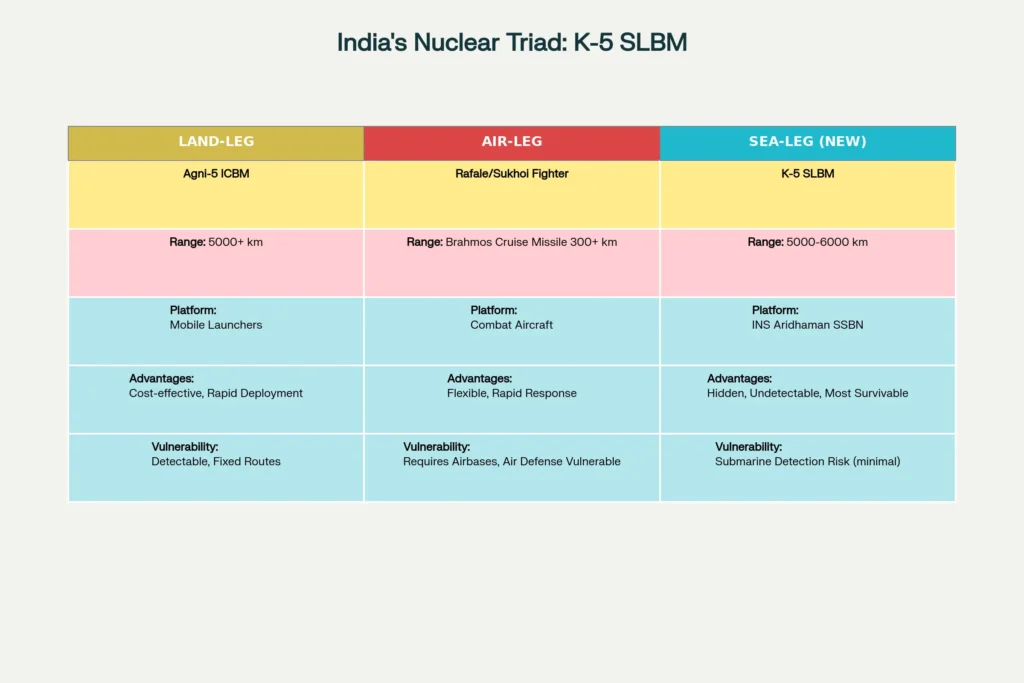
Air-Leg: Combat aircraft (Rafale, Sukhoi Su-30 MKI, HAL Tejas Mark II) equipped with nuclear-capable air-to-surface missiles like the Brahmos cruise missile. Aircraft offer strategic flexibility and rapid response capability. However, they are vulnerable to enemy air defences and require operational airbases, which can be targeted and destroyed.
Sea-Leg: Nuclear-powered ballistic missile submarines (SSBNs) carrying submarine-launched ballistic missiles (SLBMs). Submarines remain submerged for months, concealed from detection. A submarine armed with nuclear missiles can launch a devastating retaliatory strike even if the enemy has destroyed all land bases and air force assets. This is the most survivable leg of the nuclear triad.
Why the Sea-Leg Was India’s Strategic Weak Point
Until recently, India’s submarine-based nuclear deterrence was relatively weak:
- INS Arihant (India’s first SSBN, commissioned 2016) carries only four K-15 Sagarika missiles (750 km range). From the Bay of Bengal, K-15 can threaten Pakistan and southern India, but lacks the reach to strike deep into China.
- INS Arighaat (second SSBN, commissioned 2024) carries four K-4 Kalam missiles (3,500 km range). K-4 represents a major upgrade, enabling strikes on most of China, but it still cannot reach Beijing from protected deep-water launch positions.
- This capability gap left India’s second-strike deterrent dependent on land-based systems, which adversaries could theoretically destroy in a preemptive strike.
The K-5 submarine-launched ballistic missile eliminates this vulnerability. With a 5,000–6,000 km range, Indian SSBNs can now:
- Launch from deep-water bastions in the Arabian Sea or Indian Ocean
- Strike targets anywhere in China, most of Southeast Asia, the Middle East, and beyond
- Remain concealed throughout the missile flight envelope
- Execute a credible, survivable second-strike nuclear response even if land-based systems are eliminated
How K-5 Strengthens India’s No-First-Use Nuclear Doctrine
India has adopted a “credible minimum deterrence” nuclear doctrine with a pledge of “no first use” (NFU) of nuclear weapons. This doctrine makes sense only if India can guarantee a survivable second-strike capability. In other words:
India’s strategic message: “We will never attack you with nuclear weapons first. But if you attack us with nuclear weapons, we will retaliate with devastating nuclear force, even if you destroy all our military bases.”
For this message to be credible, India must demonstrate that:
- It can absorb a nuclear first strike without losing all retaliatory capacity
- Its second strike will be unavoidable (the enemy cannot eliminate all launch platforms)
- The retaliation will be sufficient to inflict unacceptable damage on the aggressor
The K-5 SLBM submarine-based deterrent addresses all three requirements:
- Submarines are nearly impossible to hunt down entirely; at least one boat will survive a first strike
- K-5’s 5,000–6,000 km range from secure Indian waters ensures deep penetration of any adversary’s territory
- K-5’s MIRV capability enables a single boat to threaten multiple cities simultaneously
- The resulting “second-strike” deterrent is so potent that no rational adversary would initiate nuclear war
This transforms the strategic equation. Instead of an unstable “use it or lose it” environment, India’s no-first-use nuclear doctrine becomes credible and stabilising.
Strategic Parity in the Indian Ocean: Challenging China’s Dominance
China operates the JL-2 submarine-launched ballistic missile (approximately 7,000 km range) on Type 094 SSBNs. For nearly a decade, China held uncontested underwater nuclear superiority in the Indian Ocean Region (IOR).
The K-5 submarine-launched ballistic missile (5,000–6,000 km range) narrows this gap significantly. India now possesses:
- Comparable range for Indian Ocean operations
- Credible nuclear strike capability from submarines
- Strategic parity in a critical region where China and India compete for influence
Future iterations (K-6 SLBM with 8,000 km range, currently under development) will exceed Chinese capabilities. This shift has geopolitical ramifications:
- India can no longer be dismissed as a “junior” nuclear power
- The Indian Ocean becomes a contested theatre for strategic submarine deterrence
- Regional powers (Japan, Vietnam, South Korea, Australia) view Indian capability development favorably
- China must recalibrate its military strategy in the IOR
Advanced Technology Behind K-5
The K-5 Stage-2 motor relies on HD 1.3 composite propellant—an advanced formulation developed by DRDO’s High Energy Materials Research Laboratory (HEMRL) in Pune. This propellant represents a significant leap in indigenous rocket motor technology.
Propellant Composition:
- Oxidiser: Ammonium perchlorate (AP) crystals
- Fuel: Aluminium powder (provides energy release)
- Binder: HTPB (hydroxyl-terminated polybutadiene) or advanced composite binders
- Additives: Burn rate catalysts, ballistic modifiers, and thermal stabilisers
Why HD 1.3 Is Superior:
- Higher specific impulse (Isp): Delivers more thrust per kilogram of propellant compared to older formulations
- Consistent burn rate: The HD 1.3 grain (finocyl configuration with 9 fins) ensures predictable thrust output
- Lightweight: Enables smaller, more efficient motor casings
- Temperature stability: Maintains performance across extreme thermal conditions
- Long shelf life: Remains effective for 15+ years without degradation
Cold-Launch Technology: Submarine-Specific Innovation
Traditional land-launched missiles ignite their engines immediately upon takeoff. But submarine-launched missiles require a different approach—the missile must be ejected from the submarine launch tube without engine ignition, then powered up after exiting the water.
How K-5 Cold-Launch Works:
- Gas Generator Initiation: A separate high-pressure gas generator (similar to airbag deployment systems) pressurises a canister to 300+ atmospheres
- Mechanical Ejection: This high-pressure gas rapidly expands, forcing the K-5 missile upward through the launch tube and out of the submarine
- Water-Surface Breach: The missile travels through water (experiencing extreme hydrostatic pressure and drag) and breaches the ocean surface
- Air-Start Ignition: Once airborne and clear of the submarine, the rocket engine ignites and propels the missile forward
Why This Is Technically Difficult:
- The missile experiences sudden acceleration (from zero to several G’s in milliseconds)
- Thermal shock occurs as the missile transitions from cold seawater to hot air
- Sensitive electronics and guidance systems must survive mechanical shock
- The Stage-2 motor must restart reliably after mechanical stress
The K-5 Stage-2 motor test success specifically validated that the Stage-2 motor can ignite reliably after cold-launch mechanical and thermal shock.
Advanced Composite Motor Casings
The K-5 rocket motor casing is constructed from advanced carbon-fibre composite materials rather than traditional steel or aluminium alloys. This represents a materials science achievement:
Traditional Steel Motor Casings:
- Weight: Heavy (specific strength lower)
- Cost: Lower material cost, but heavier overall system
- Problem: Heavy casing reduces payload capacity and range
Advanced Composite Casings (K-5 Specification):
- Material: Carbon-fibre-reinforced polymer (CFRP) with advanced epoxy resin
- Weight reduction: 40-50% lighter than equivalent steel casings
- Strength: Withstands 200+ atmospheres of internal pressure
- Advantage: Reduced overall missile weight enables longer range or larger payload
Manufacturing Challenge:
Creating consistent composite casings requires:
- Precise fibre layup sequences (fibre orientation critical for load distribution)
- Vacuum-bag curing to eliminate air voids
- Rigorous quality control (any fibre misalignment creates weak points)
- Temperature management during curing
The K-5 Stage-2 motor test validated that DRDO can manufacture these composite casings consistently and reliably.
Deep Finocyl Grain Configuration: Burn-Rate Engineering
The propellant grain (solid propellant shape) inside the K-5 Stage-2 motor uses a deep finocyl configuration—essentially a solid cylinder with nine radial fins cut into it. This geometry serves multiple purposes:
- Increased Burn Surface Area: The nine fins dramatically increase the surface area where propellant burns. More burning surface = more thrust generation
- Burn-Rate Consistency: The fin geometry is engineered to maintain constant surface area as the propellant burns. This ensures constant thrust output throughout the burn duration
- Pressure Management: The progressive geometry prevents pressure spikes or dips during combustion
- Acoustic Signature Control: The specific fin pattern modulates combustion noise, reducing the acoustic signature during submarine launch
The finocyl grain design is a proven technology used in space launch rockets worldwide, but adapting it for submarine-launched missiles requires specific optimisation, which the K-5 Stage-2 motor test successfully validated.
Nozzle Design & Thrust-Vector Control
The K-5 missile’s nozzle assembly incorporates thrust-vector control (TVC) capability. This means the nozzle can shift slightly during powered flight, enabling the missile to adjust its trajectory mid-flight for guidance corrections.
TVC Mechanism:
- Electro-mechanical actuators move the nozzle in pitch and yaw directions
- Guidance system sends real-time commands to TVC actuators
- Result: Missile flight path can be adjusted to counteract winds, maintain accuracy
Why TVC Matters for Submarine-Launched Systems:
- Submarines launch from moving platforms (even slight ship motion affects launch geometry)
- Ocean waves create disturbances affecting initial trajectory
- TVC corrects for these environmental variables in real-time
- Enables pinpoint accuracy at 5,000+ km ranges
The Stage-2 motor test included nozzle performance validation, confirming that the TVC system functions reliably under extreme combustion conditions.
Challenges and Technical HurdlesDeployment
The November 2025 K-5 Stage-2 motor static test success validates only one component of a complex system. The next phase requires full missile integration:

Stage-1 Motor Integration:
- Must couple the Stage-1 motor (underwater boost) with Stage-2
- The separation mechanism must reliably detach Stage-1 after burnout
- Thermal and acoustic loads from Stage-1 must not damage Stage-2
Guidance System Integration:
- Inertial measurement unit (IMU) must survive launch accelerations (20+ G’s)
- Navigation algorithms must process IMU data in real-time
- The celestial update system must function during powered flight
Warhead Integration:
- Re-entry vehicle (RV) must withstand Stage-3 separation loads
- RV thermal protection must survive atmospheric re-entry (speeds exceeding Mach 25)
- Warhead fusing and arming systems must function reliably
Fire-Control System Integration:
- Submarine’s combat management system must interface with missile launch systems
- Command links must transmit target coordinates securely underwater
- Launch authorisation protocols must meet nuclear weapon safety standards
FAQs| DRDO tested K-5 SLBM Stage-2 Motor Successfully
1. Why is the K-5 Stage-2 motor test important for India’s defence?
The Stage-2 motor provides mid-flight thrust that determines whether the K-5 missile achieves its 5,000–6,000 km range and accuracy. Successful static testing validates that India’s indigenous propulsion technology is reliable and production-ready. This removes a critical technical risk from the K-5 development timeline and proves India’s ability to develop sophisticated submarine-launched ballistic missiles independently.
2. How does K-5 differ from K-4 missile?
K-4 has a 3,500 km range; K-5 reaches 5,000–6,000 km. K-5 enables submarines to strike distant Chinese targets from secure Indian Ocean waters, matching land-based Agni-5 capability. K-5 is also optimised for future S4-class submarines (larger tubes), while K-4 fits existing Arihant-class submarines. K-5 represents a generational advancement in submarine-based deterrence.
3. What is a “static test” in submarine missile development?
A ground-based, non-flight test where the rocket motor burns under controlled conditions. Engineers use over 250 instrumentation channels to measure thrust output, combustion pressure, burn time, and structural integrity without launching the missile. Static testing validates motor design before costly and risky flight trials.
4. When will K-5 missiles become operational on Indian submarines?
After successful underwater launch trials (expected 2025-2027), series production will begin. Operational deployment is estimated for 2027-2028, with INS Aridhaman serving as the primary platform. Full operational status with continuous at-sea deterrent operations may extend to 2028-2029.
5. How does K-5 fit India’s “no first use” nuclear doctrine?
India pledges never to use nuclear weapons first but reserves the right to retaliate with nuclear weapons if attacked. This doctrine is only credible if India maintains a survivable second-strike capability. Submarine-based K-5 missiles provide that survivability—even if land and air forces are destroyed, submarines can retaliate. K-5 makes India’s no-first-use pledge genuinely credible.
6. What is MIRV, and why does K-5 need it?
MIRV (Multiple Independently Targetable Re-entry Vehicle) allows one missile to carry multiple warheads, each striking a different target. K-5’s MIRV capability multiplies deterrence value—adversaries face the prospect of multiple simultaneous nuclear strikes from a single missile. This increases the cost and unacceptability of nuclear aggression.
7. Which Indian submarines will carry K-5?
INS Aridhaman (third SSBN, induction 2026-2027) will be the primary K-5 platform. Future S4-class submarines (three boats planned, first induction 2028) will also carry K-5. Existing INS Arihant and INS Arighaat will continue to carry K-15 and K-4 missiles, respectively, due to design constraints.
8. How does K-5 compare to Chinese and Russian submarine missiles?
China’s JL-2 SLBM has a 7,000 km range (somewhat longer than K-5’s 5,000–6,000 km); Russia’s R-39 has an 8,000 km range (older design). K-5 provides India with competitive parity for Indian Ocean operations. Future K-6 SLBM (8,000 km range) will exceed most competitors and match Russia’s modern designs.
9. What challenges remain before K-5 deployment?
Full missile integration (combining three stages, guidance systems, warheads), underwater launch trials from submarines, production scale-up, submarine platform modifications, and MIRV validation. These phases will extend through 2027. Challenges are substantial but technically surmountable based on Stage-2 motor test success.
10. Does K-5 success change India-Pakistan strategic balance?
Yes, significantly. K-5 vastly outranges Pakistani submarine-based systems. India’s underwater deterrent becomes impervious to Pakistani conventional or nuclear attacks. Pakistan cannot threaten India’s K-5-armed submarines, reinforcing India’s strategic superiority in South Asia. The strategic balance tilts decisively in India’s favour.
India’s Nuclear Triad Now Complete—Strategic Implications for Asia’s Future
The November 2025 DRDO K-5 submarine-launched ballistic missile Stage-2 motor static test success marks a watershed moment in India’s strategic evolution. This test validates not just a rocket motor, but an entire nation’s capacity to develop sophisticated nuclear deterrence systems independently, without foreign assistance or technology dependence.
The K-5 SLBM represents the missing piece of India’s nuclear triad puzzle. For the first time, India possesses a credible, submarine-based, survivable second-strike nuclear deterrent. The strategic implications are profound:
For India:
- Nuclear deterrence doctrine transforms from theoretical to operationally credible
- Strategic autonomy increases as foreign technology dependence decreases
- International status rises as recognition as an established nuclear power solidifies
- Regional influence expands across the Indian Ocean and the Asia-Pacific regions
For the Strategic Balance:
- Indian Ocean transforms from China’s strategic sanctuary to a contested deterrence domain
- Regional nations gain confidence in India as a stabilising security partner
- The nuclear calculus in South Asia has fundamentally changed in India’s favour
For Global Security:
- India’s credible second-strike capability enhances strategic stability (no pressure for preemptive strikes)
- Nuclear proliferation calculus remains stable (India develops systems independently, doesn’t fuel arms race)
- International prestige and influence shift toward India as a mature, responsible nuclear power
The K-5 submarine-launched ballistic missile Stage-2 motor test success is not merely a technical achievement—it is a strategic turning point that cements India’s position as a major nuclear power capable of designing, developing, and deploying its own strategic weapons systems.
Looking ahead, the underwater launch trials of 2025-2027, the operational deployment of 2027-2028, and the eventual continuous at-sea deterrent operations represent India’s trajectory toward the ranks of the world’s most strategically powerful nations. The K-5 SLBM marks the moment when India’s nuclear triad moved from aspiration to reality.


